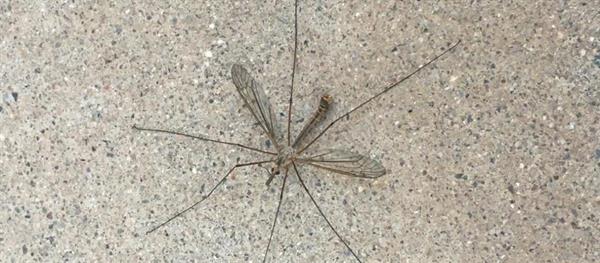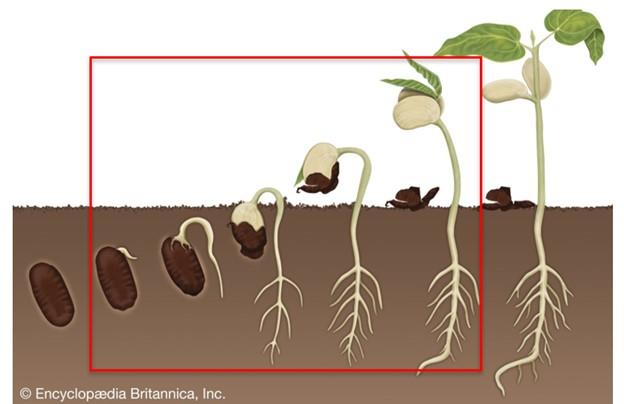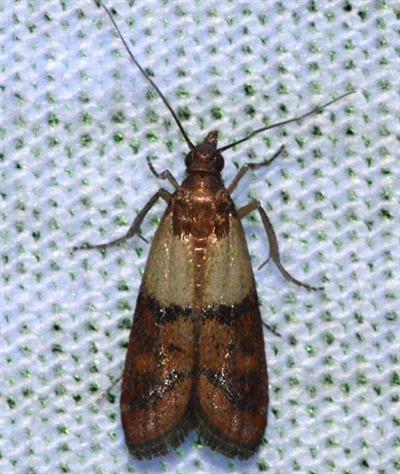
Please take this short 5-question survey about our newsletter:
https://uarizona.co1.qualtrics.com/jfe/form/SV_cMhZ82JodDKJgCa
Shujuan Li and W. Eugene Hall
Department of Entomology, University of Arizona

Figure 1. An adult crane fly resting on the ground at Maricopa Agricultural Center, Maricopa AZ.
Photo: Shujuan Li.
As the weather warms up, residents in Arizona start to notice giant insects landing or flying around our homes or offices (Figures 1 & 2). People call them giant mosquitoes, but these gentle giants are not mosquitoes at all. They are actually crane flies and are harmless.
Crane fly, a member of the fly family Tipulidae (order Diptera, meaning two-winged insects), looks like a mosquito, but is not a mosquito. Crane flies have a slender mosquito-like body and extremely long legs. Adult crane flies can range from tiny to almost 1.2 inches long. These slow-flying insects are harmless and usually found around water or among abundant vegetation.
Crane fly adult females generally deposit their eggs in damp areas or in grass. Lawns near wooded areas or open fields often have a population of crane flies. Dampness and heavy rainfall can increase their numbers. Each egg hatches into a long slender larva, called a leather jacket due to its tough brown skin. Only in their larval stage do crane flies cause any potential damage. The larvae usually feed on decaying plant tissue, and damage the roots of cereal and grass crops, sometimes leaving large brown patches on lawns, but generally are beneficial soil dwellers feeding on organic matter. The larvae feed all winter, followed by a resting stage in the spring. The adults generally show up in late winter or early spring, occasionally in large numbers. Adult crane flies generally do not feed, though some species may take nectar from flowers.

Figure 2. An adult crane fly resting on a plant. Photo: Shutterstock.
Adult crane flies are attracted to lights and often annoy residents when they fly into homes and bump against walls or ceilings. Although they look like giant mosquitoes, they do not bite people or feed on blood because they don’t have the sucking mouth parts that mosquitoes have. Mature crane flies only live up to two weeks, long enough to complete their reproductive cycle. Residents may see or observe dead adult crane flies on grounds around homes and buildings shortly after their lifecycle has completed.
This information is also available as an article on our Extension page https://extension.arizona.edu/crane-flies.
It is also available to view and print as an IPM short: https://acis.cals.arizona.edu/docs/default-source/default-document-library/crane-flies-ipm-shorted861f95341545938d9469d11614ab70.pdf.
Shaku Nair and Kai Umeda
Maricopa County Cooperative Extension
As the weather warms up after a wet winter, another group of “pests” you will see, are weeds! (Figures 3 & 4). This is also a great time to consider pre-emergent herbicides.

Figure 3. An assortment of grass and broadleaved weeds growing in a yard, following winter rains.
Photo: Shaku Nair.

Figure 4. Broadleaved weed infestation in a lawn, just as the Bermuda breaks out of dormancy.
Photo: Shaku Nair.
“Pre-emergent” herbicides, as the name suggests, are herbicides that act before weed seeds emerge out of the ground. This is a great preventative or proactive weed control strategy! Pre-emergent herbicides act by inhibiting plant root growth, seed cell division or by inhibiting specific enzymes essential to the growth of plants.
A well-timed application of pre-emergents in early spring can keep your lawns and landscapes weed-free through much of the spring, and even into summer. Later, a second application timed with the monsoon rains can provide control through the fall. Thus, pre-emergent herbicides can greatly reduce the number of herbicide applications in a year.
Typically, there are large quantities of weed seeds in the soil, waiting to germinate when favorable conditions (namely, the right temperature and moisture). After winter rains, when the soil starts to warm up in the spring, these seeds start putting out shoots through the soil, and roots down into the ground. This is the ideal time to apply pre-emergent herbicides, which stop seedling roots and shoots from growing. If you miss the ideal time to apply pre-emergents, you may have to make multiple applications of post-emergent herbicides which act on weeds that have already emerged out of the soil and are actively growing. In Figures 3 and 4 show established weeds in a yard and a lawn, where it is too late to apply pre-emergents.
For pre-emergent herbicides to be effective, the product has to be applied evenly across the soil surface, and then incorporated within the zone where weed seeds generally germinate at the top 2-3 inches of the surface. Mechanical mixing with a disk or harrow usually works well on well-tilled bare ground. “Watering in” is also required for the herbicide to be activated. In turf and landscapes, rainfall or overhead irrigation help the herbicide to be “activated” in the upper surface layers. Generally, the herbicide attaches to organic matter and/or clay components of the soil particles where they contact the roots.
The product label will specify that adequate rainfall or sprinkler irrigation should occur within a month or so to ensure the herbicide is "activated". Otherwise, exposure on the soil surface to sunlight will result in breakdown of the herbicide and reduced weed control efficacy.
Pre-emergent weed control products should be applied when the soil temperature is 50-55 °F. Normally, this is by the end of February/early March in Tucson and Phoenix, and by early to mid-February in Yuma. Likewise, similar temperatures occur in mid-May in Flagstaff. Soil temperatures can be found at the following web site http://cals.arizona.edu/AZMET.
There are several active ingredients that are often sold under a variety of branded product names. Commonly sold active ingredients of pre-emergent herbicides include the following: trifluralin, benefin, pendimethalin, oryzalin, prodiamine, dithiopyr, metolachlor, dimethenamid, and oxadiazon.
Small-seeded broadleaved annual weeds such as spurge and purslane can be controlled by the same pre-emergent herbicides used against the grass weeds. Herbicide products containing the active ingredient, isoxaben can control additional broadleaved weeds with pre-emergent applications to the soil.
Some pre-emergent herbicides are also formulated with the active ingredient attached to a granular fertilizer. This can offer some convenience since a fertilizer application can be made when applying suitable pre-emergence weed control agent. These types of products are often referred to as “weed and feed” products.
Active ingredients and product references included are provided for technical/educational purposes and examples only. No recommendations or exclusions are intended, or implied.
Read our publication on selecting the right herbicide: https://extension.arizona.edu/sites/extension.arizona.edu/files/pubs/az1914-2021.pdf
Will pre-emergent herbicides affect standing plants?
Pre-emergent herbicides will not affect established plants, trees or turf. They will not affect weed seeds in the ground either. Figure 5 shows the phases of seed germination, and the red square shows the window in which pre-emergents will be effective.


Identify this insect (from our January-February newsletter)
Answer: Indian Meal Moth Plodia interpunctella, a common household pest which feeds on stored food of various kinds including grain, seeds, dried fruit, pet food, and lots more.
Congratulations to Master Pest Detective Violet Wielgus, ASU.

Identify this common weed.
If you know the answer, email Dawn at dhgouge@arizona.edu. You will not win anything if you are correct, but you will be listed as a “Master Pest Detective” in the next newsletter issue.
https://uarizona.co1.qualtrics.com/jfe/form/SV_cMhZ82JodDKJgCa

In-person April 23-24, 2024
Online April 29 – May 31, 2024
Conference information: https://acis.cals.arizona.edu/community-ipm/events/arizona-school-ipm-conference
For paper registration using check/Purchase Order, please email nairs@arizona.edu.
Email nairs@arizona.edu if you have questions.
____________________________________________________________

MAY 10, 2024
(In-person only)
EL CONQUISTADOR HOTEL, TUCSON
Registration and Conference Information at Front | Desert Horticulture Conference (arizona.edu)
____________________________________________________________

Elevate your career, expand your network, and stay at the forefront of the pest management industry. https://www.azppo.org/event-5234386
Why Attend?
Earn 6 CEUs Per Day: Stay ahead in your field with valuable Continuing Education Units (CEUs) each day. Elevate your expertise and knowledge!
Top-Notch Exhibit Hall: Immerse yourself in a cutting-edge exhibit hall showcasing the latest advancements, technologies, and solutions. Connect with industry leaders and discover groundbreaking products.
📍 Location: Mesa Convention Center | 263 N. Center St. Mesa, AZ 85201
Register at https://www.azppo.org/Conference
____________________________________________________________
EPA Webinars about Integrated Pest Management
View recordings of archived EPA Integrated Pest Management Webinars at https://www.epa.gov/managing-pests-schools/upcoming-integrated-pest-management-webinars.
For more information about the EPA Schools program: http://www.epa.gov/schools/
____________________________________________________________
Urban and Community IPM Webinars University of California
UC Statewide IPM Program Urban and Community webinar series is held the third Thursday of every month to teach about pest identification, prevention and management around the home and garden. This series is free but advanced registration is required. Dates and topics below, all begin at noon Pacific. https://ucanr.edu/sites/ucipm-community-webinars/
___________________________________________________________
What’s Bugging You? First Friday Events (New York State IPM Program)
Fridays | 12:00 pm. – 12:30 p.m. EDT | Zoom | Free; registration required
In this monthly virtual series, we explore timely topics to help you use integrated pest management (IPM) to avoid pest problems and promote a healthy environment where you live, work, learn and play. What is IPM? It's a wholistic approach that uses different tools and practices to not only reduce pest problems, but to also address the reasons why pests are there in the first place. Each month, our speakers will share practical information about how you can use IPM. Register for upcoming events.
What’s Bugging You First Friday events are also available in Spanish. Individuals interested in these events can find more information on this website: https://cals.cornell.edu/new-york-state-integrated-pest-management/outreach-education/events/whats-bugging-you-webinars/conozca-su-plaga___________________________________________________________
11th International IPM Symposium Webinar series:
Nurturing Nature in New Ways to Manage Pests March 25, 2024 | 1 p.m. CT
Merging science and business by offering the latest research, strategies and solutions, IPM Symposium is proud to announce a new quarterly webinar series. Kicking off March 25, 2024 with Janet Hurley’s “Nurturing Nature in New Ways to Manage Pests,” this series will explore the most pressing issues for the entire integrated pest management community.
Pests are thieves. They can steal nutrients from plants, inject harmful viruses into our systems and can destroy acres of crops in a single night. Insects can be beneficial! They can pollinate, but they can also be plentiful to the point of being a nuisance. One thing is for sure - they are here to stay. Understanding that nature needs nurturing for both good and bad pests, this webinar will discuss finding that balance.
Register here: https://us06web.zoom.us/webinar/register/WN_F7swXsiYSOO_EubwhSmGnw#/registration
___________________________________________________________
To view previous University of Arizona newsletters, visit: https://acis.cals.arizona.edu/community-ipm/home-and-school-ipm-newsletters.
Acknowledgements
This material is in part funded by the National Institute of Food and Agriculture, U.S. Department of Agriculture, under award number 2021-70006-35385 that provides Extension IPM funding to the University of Arizona. It is funded in part by the USDA National Institute of Food and Agriculture through the Western Integrated Pest Management Center, grant number 2018-70006-28881. Additional support is provided by the UA Arizona Pest Management Center and Department of Entomology. Any opinions, findings, conclusions, or recommendations expressed in this publication are those of the authors and do not necessarily reflect the views of the U.S. Department of Agriculture or those of other funders.
We respectfully acknowledge the University of Arizona is on the land and territories of Indigenous peoples. Today, Arizona is home to 22 federally recognized tribes, with Tucson being home to the O’odham and the Yaqui. Committed to diversity and inclusion, the University strives to build sustainable relationships with sovereign Native Nations and Indigenous communities through education offerings, partnerships, and community service.